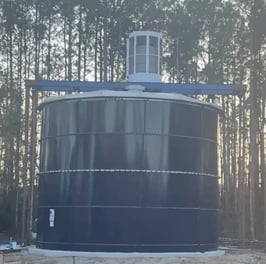
"Oxidation" refers to electron loss from a reducing agent. It is common to say that "the process has been oxidized."
]Electrons carry negative charges, and the oxidation process leads to an increase in positive valence.
During oxidation, the number of electrons orbiting an element decreases, causing the element to form bonds with oxygen when oxygen is present. Oxygen is naturally attracted to electrons.
Iron can exist in various forms in water, with the most prevalent being ferrous bicarbonate (C2H4FeO6), which is soluble.
Ferrous iron possesses a positive two valence. As ferrous iron undergoes oxidation, the number of electrons decreases, resulting in the development of a positive three valence known as ferric hydroxide: Fe(OH)3.
The most cost-effective method of oxidizing iron in water is thorough aeration using an "aeration tower." The aerator is very similar to a degasification tower or air stripper as it utilizes either forced draft or induced draft air movement to create the enriched oxygen environment needed.
Typically, the aerator employs the "impingement process," a technique that effectively modifies the shape of water molecules by subjecting them to controlled impacts.
This transformative process plays a crucial role in exposing the iron in the water to abundant oxygen, creating favorable conditions for the facilitation of electron flow. As a result, the impingement process greatly contributes to the promotion of iron oxidation, driving the conversion of ferrous iron to its oxidized form.
Aerator towers, known for their durability and longevity, are constructed using high-quality materials such as fiberglass or aluminum. These materials are carefully chosen to withstand the rigors of water treatment operations and ensure the tower's structural integrity over an extended period. With proper maintenance and upkeep, aerator towers have a remarkable lifespan exceeding 30 years, making them a reliable and cost-effective choice for iron oxidation.
One of the key advantages of aerator towers lies in their superior efficiency compared to diffusers or air compressors. While diffusers and air compressors can provide aeration, aerator towers offer a distinct advantage by continuously reshaping the water as it passes through the tower. This constant reshaping enhances the exposure of iron in the water to the surrounding oxygen-rich environment, facilitating the oxidation process more effectively.
The heart of an aerator tower lies in its media bed, which plays a crucial role in maximizing iron exposure to oxygen. The media bed serves as a medium through which water flows, and its design is optimized to create ideal conditions for iron oxidation. Aerator towers ensure efficient and consistent iron oxidation by utilizing a specific type of media, carefully chosen based on factors such as iron concentration and anticipated fouling rate.
Compared to alternative methods, such as diffusers or air compressors, the use of an aerator tower with a media bed proves to be highly advantageous. The continuous reshaping of water within the tower and the strategic media bed design enable a greater surface area for iron exposure to oxygen. This optimized configuration ensures a more thorough and efficient oxidation process, improving water quality and reducing maintenance requirements.
Aerator towers constructed from fiberglass or aluminum materials offer exceptional longevity and reliability, surpassing 30 years of service with proper maintenance.
Their efficiency outshines diffusers and air compressors due to the continuous reshaping of water and the utilization of a media bed, which optimizes iron exposure to oxygen. By leveraging the advantages of aerator towers, water treatment systems can achieve efficient iron oxidation, contributing to enhanced overall performance and long-term cost savings.
The media bed within an aerator can vary based on the concentration of iron and the anticipated fouling rate. DeLoach Industries employs a proprietary slat tray media that shed iron fouling, reducing maintenance requirements.
Some towers utilize random packing, but this type of packing can cause issues during the iron oxidation process and lead to additional expenses due to cleaning and replacement needs.
The dissolved oxygen levels should be at least 15% of the total iron content to oxidize iron fully. Aeration towers create a sufficient oxygen environment, allowing iron and oxygen to bond when both are present.
The water should not be acidic for the oxidation of soluble ferrous bicarbonate to insoluble ferric hydroxide precipitate (Fe(OH)3). To learn more about water treatment or obtain further information, please contact the professionals at DeLoach Industries Inc. at (941) 371-4995.
Receive Your Free Odor Control E-Book
Related Blog: Why You Should be Using a Decarbonator to Lower Co2 Levels & Raise the PH of the Water




